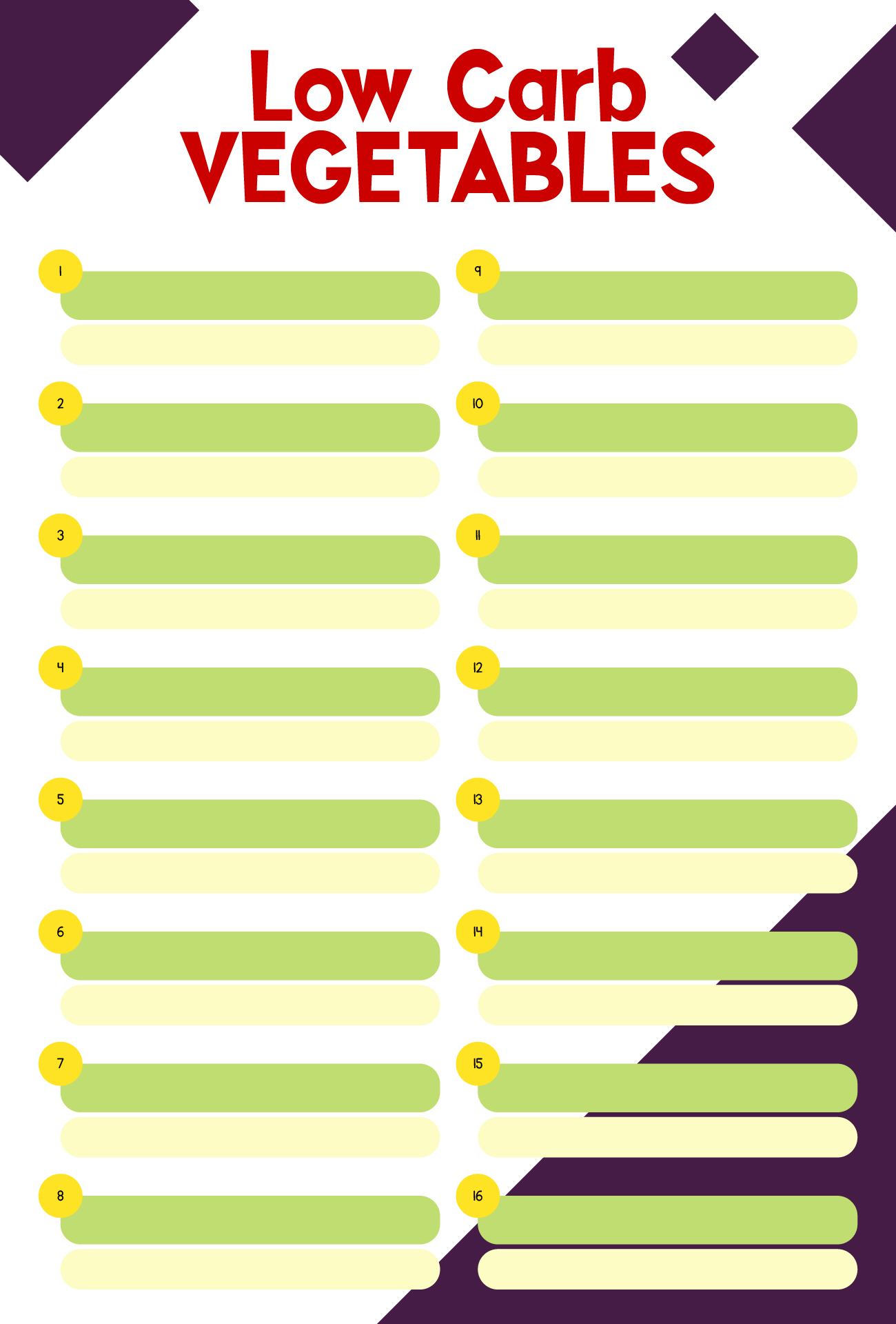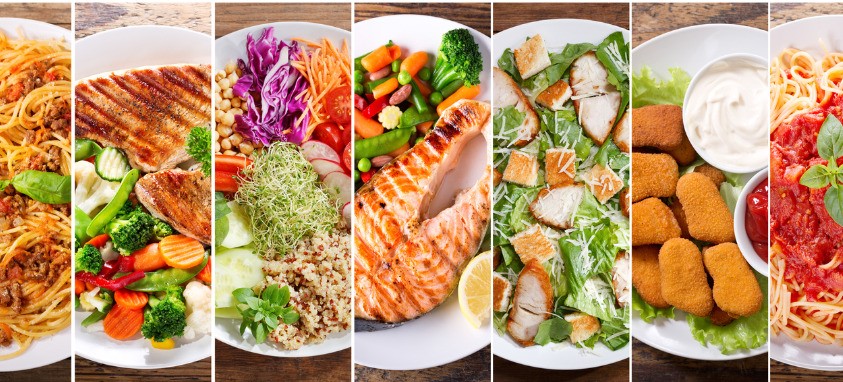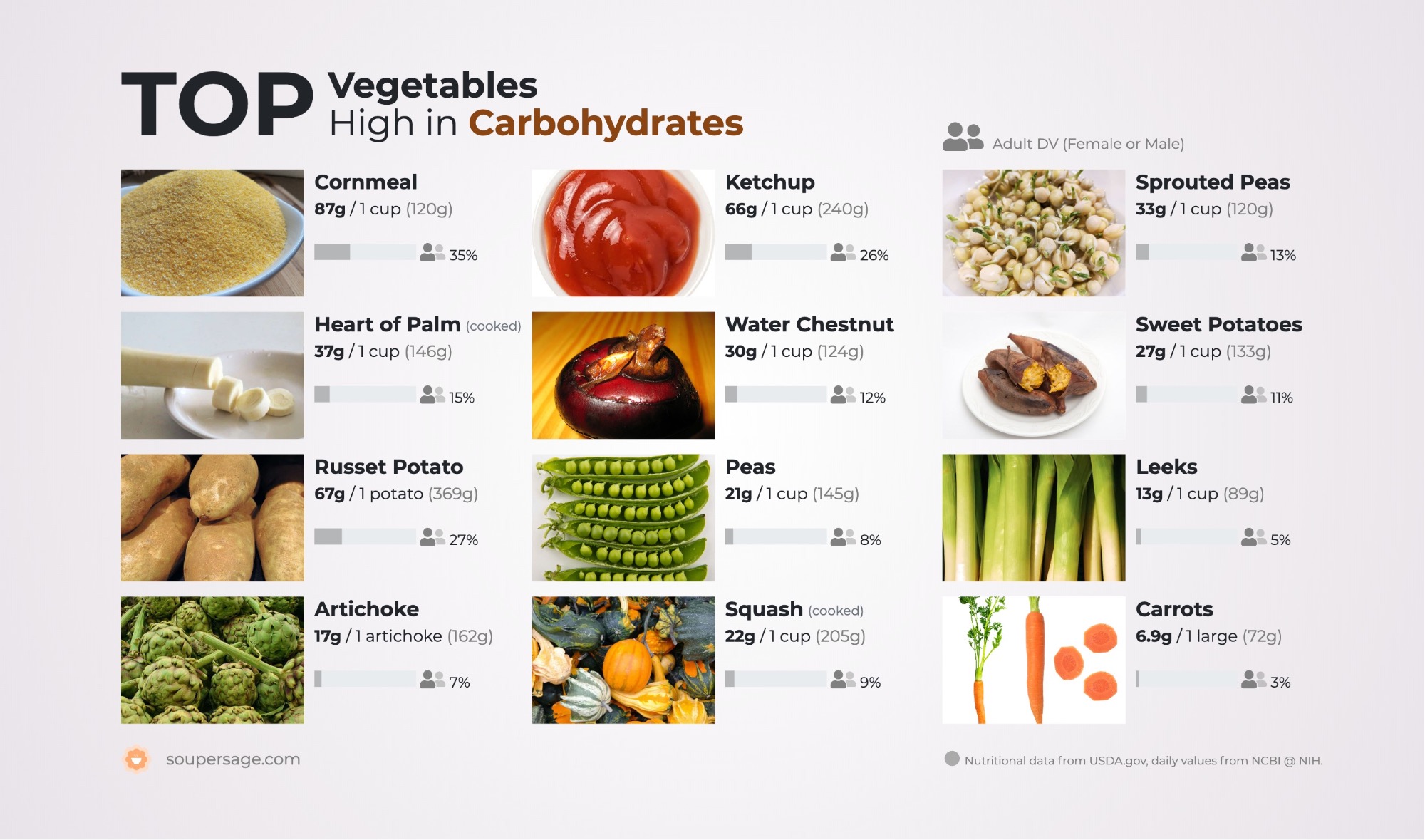The Benefits of Carb-Rich Vegetables
Carb-rich vegetables, also known as starchy vegetables, offer numerous health advantages. These nutrient-dense powerhouses provide complex carbohydrates, which are essential for maintaining energy levels and supporting overall health. Including carb-rich vegetables in one’s diet can lead to improved gut health, sustained energy levels, and a reduced risk of chronic diseases.
First, carb-rich vegetables are an excellent source of dietary fiber, which promotes healthy digestion and supports a balanced gut microbiome. The fiber found in these vegetables helps regulate bowel movements, prevent constipation, and reduce the risk of developing digestive disorders such as irritable bowel syndrome and diverticulitis.
Moreover, carb-rich vegetables offer a slow-release energy source, making them an ideal choice for those seeking to maintain stable blood sugar levels. Unlike simple carbohydrates found in refined sugars and processed foods, complex carbohydrates found in vegetables are broken down more gradually, providing a steady supply of energy throughout the day. This can help prevent energy crashes and promote satiety, reducing the likelihood of overeating.
Lastly, a diet rich in carb-rich vegetables has been associated with a reduced risk of chronic diseases, including type 2 diabetes, heart disease, and certain types of cancer. These vegetables contain various essential vitamins, minerals, and antioxidants that contribute to overall health and well-being. For instance, potatoes are high in vitamin C and B6, while squash is rich in vitamin A and carotenoids. By incorporating these vegetables into one’s diet, individuals can reap the benefits of their disease-fighting properties.
Identifying the Top Carb-Rich Vegetables
Carb-rich vegetables, also known as starchy vegetables, are an essential component of a balanced, nutrient-dense diet. These vegetables provide complex carbohydrates, which serve as the body’s primary energy source. Among the top carb-rich vegetables are potatoes, peas, corn, and various squashes. Each of these vegetables offers a unique nutritional profile and potential health benefits.
Potatoes, for instance, are high in vitamin C, B6, and potassium, making them an excellent choice for supporting immune function, energy production, and heart health. Additionally, sweet potatoes and yams are rich in beta-carotene, a powerful antioxidant that can help protect the body against cellular damage and reduce the risk of chronic diseases.
Peas, another carb-rich vegetable, are packed with protein, fiber, and various essential vitamins and minerals. Green peas, in particular, are high in vitamin K, manganese, and thiamin, contributing to bone health, antioxidant defenses, and energy production. Furthermore, they are a sustainable and environmentally-friendly protein source, making them an attractive option for those seeking to reduce their meat consumption.
Corn, often consumed as a grain rather than a vegetable, is a versatile and nutritious carb-rich option. It is high in fiber, vitamin C, and several B vitamins, supporting digestive health, immune function, and energy metabolism. Additionally, corn contains lutein and zeaxanthin, antioxidants that promote eye health and may reduce the risk of age-related macular degeneration.
Lastly, squashes, such as butternut, acorn, and spaghetti squash, offer a wealth of nutrients and health benefits. They are high in vitamin A, vitamin C, and various minerals, contributing to immune function, antioxidant defenses, and bone health. Moreover, their versatile nature allows for various culinary applications, making them an exciting and creative addition to any meal.
How to Incorporate Carb-Rich Vegetables into Meals
Incorporating carb-rich vegetables into daily meals can be both practical and creative. These versatile ingredients can be enjoyed at any time of day, offering a wealth of nutrients and health benefits. Here are some suggestions for breakfast, lunch, dinner, and snack options:
Breakfast: Start the day with a serving of carb-rich vegetables by incorporating them into omelets, frittatas, or breakfast burritos. Roasted sweet potatoes, sautéed spinach, and grilled bell peppers make delicious and nutrient-dense additions to any morning meal. Alternatively, try a smoothie bowl with frozen butternut squash or pumpkin puree, topped with fresh berries, nuts, and seeds.
Lunch: For a satisfying and balanced lunch, consider a hearty salad with quinoa, roasted root vegetables, and a variety of leafy greens. Or, try a vegetable-packed wrap with hummus, avocado, and your choice of carb-rich vegetables. Soups and stews are also excellent options for incorporating these vegetables, providing warmth and comfort during colder months.
Dinner: Carb-rich vegetables can serve as the foundation for many dinner dishes. For instance, try a stuffed bell pepper or acorn squash, filled with a mixture of grains, vegetables, and spices. Alternatively, create a vegetable-centric pasta dish using spiralized zucchini or spaghetti squash as a low-carb, nutrient-dense alternative to traditional pasta.
Snacks: Carb-rich vegetables make for convenient and nutritious snacks. Roasted chickpeas, sweet potato fries, or steamed edamame are all delicious options. For a quick and easy snack, try pairing raw vegetables, such as carrots, celery, or cherry tomatoes, with a flavorful hummus or dip.
Comparing Carb-Rich Vegetables to Other Carbohydrate Sources
Carb-rich vegetables offer several advantages over other carbohydrate sources, such as grains and legumes. While these alternative sources can also contribute to a balanced, nutrient-dense diet, carb-rich vegetables often provide higher levels of essential vitamins, minerals, and antioxidants. Moreover, vegetables typically have a lower glycemic load than grains and legumes, meaning they cause a slower, more stable increase in blood sugar levels.
For instance, carb-rich vegetables like sweet potatoes, beets, and carrots are high in vitamin A, a fat-soluble vitamin that plays a crucial role in vision, immune function, and cellular growth. Additionally, these vegetables contain various antioxidants, such as beta-carotene, anthocyanins, and lutein, which help protect the body against oxidative stress and chronic diseases. In contrast, grains and legumes often contain fewer of these beneficial compounds.
Furthermore, carb-rich vegetables generally have a lower glycemic load than grains and legumes, making them a more suitable option for those seeking to manage their blood sugar levels. The glycemic load of a food is a measure of how quickly it raises blood sugar, taking into account both the quantity and quality of carbohydrates it contains. Foods with a low glycemic load, such as non-starchy vegetables and many carb-rich vegetables, cause a slower, more stable increase in blood sugar, reducing the risk of energy crashes and promoting satiety.
That being said, it is essential to recognize the value of variety and balance in one’s diet. Incorporating a mix of carb-rich vegetables, grains, and legumes can help ensure a diverse intake of essential nutrients and promote overall health and well-being. By understanding the unique benefits of each carbohydrate source, individuals can make informed decisions about their food choices and create a balanced, nutrient-dense meal plan that meets their individual needs and preferences.
Considerations for Those with Dietary Restrictions
While carb-rich vegetables offer numerous health benefits, some individuals may have dietary restrictions that limit their consumption of certain vegetables. For instance, those with gluten intolerance or celiac disease may need to avoid grains, making it essential to find alternative sources of carbohydrates. Similarly, individuals with nightshade sensitivities may need to avoid vegetables such as tomatoes, bell peppers, and eggplants. Fortunately, there are several alternative carb-rich vegetable options available to accommodate these restrictions.
For those with gluten intolerance or celiac disease, root vegetables like sweet potatoes, beets, and parsnips can serve as excellent sources of complex carbohydrates. These vegetables are high in fiber, vitamins, and minerals, making them a nutritious and satisfying alternative to grains. Additionally, winter squashes, such as butternut, acorn, and spaghetti squash, provide a hearty and filling carbohydrate source, rich in vitamin A, vitamin C, and various minerals.
Individuals with nightshade sensitivities can explore alternative carb-rich vegetables like carrots, turnips, rutabagas, and celery root. These vegetables offer a wealth of nutrients and health benefits, providing a satisfying and nutritious alternative to nightshade vegetables. Moreover, they can be incorporated into various dishes, such as roasted vegetable medleys, soups, stews, and purees, adding depth and flavor to any meal.
Regardless of dietary restrictions, it is essential to prioritize variety and balance in one’s diet. Incorporating a diverse range of carb-rich vegetables can help ensure a well-rounded intake of essential nutrients and promote overall health and well-being. By exploring alternative carb-rich vegetable options, individuals with dietary restrictions can enjoy the numerous benefits of these nutrient-dense foods while adhering to their specific dietary needs.
Seasonal Availability of Carb-Rich Vegetables
Carb-rich vegetables are available throughout the year, offering a variety of options for incorporating these nutrient-dense foods into one’s diet. Consuming locally grown, seasonal produce can provide numerous benefits, including enhanced freshness, flavor, and reduced environmental impact. By understanding the seasonal availability of carb-rich vegetables, individuals can make informed decisions about their food choices and enjoy the full range of benefits these vegetables have to offer.
During the spring and early summer months, carb-rich vegetables like asparagus, peas, and new potatoes become available. These fresh, tender vegetables are an excellent addition to salads, side dishes, and light meals. Additionally, spring is an ideal time to enjoy rhubarb, a carb-rich vegetable often used in sweet and savory dishes. Preserving spring produce through canning, freezing, or dehydrating can help ensure a steady supply of these seasonal favorites throughout the year.
As the weather warms and summer arrives, a variety of carb-rich vegetables come into season. Corn, zucchini, bell peppers, and eggplants are plentiful during the summer months, providing a wealth of options for grilling, roasting, or incorporating into fresh, vibrant salads. Late summer also brings an abundance of tomatoes, which can be enjoyed in various forms, from fresh slices to canned sauces and salsas. Preserving summer produce through canning, freezing, or dehydrating can help extend the season and provide a taste of summer throughout the year.
Autumn and early winter mark the arrival of hearty carb-rich vegetables like winter squashes, sweet potatoes, and carrots. These root vegetables are well-suited for roasting, pureeing, or incorporating into soups and stews, providing warmth and comfort during the colder months. Preserving autumn produce through canning, freezing, or dehydrating can help ensure a steady supply of these seasonal favorites throughout the winter.
By understanding the seasonal availability of carb-rich vegetables, individuals can make informed decisions about their food choices and enjoy the full range of benefits these nutrient-dense foods have to offer. Consuming locally grown, seasonal produce not only supports regional agriculture and reduces environmental impact but also ensures the freshest, most flavorful vegetables possible. Additionally, preserving seasonal produce through various methods can help extend the season and provide a taste of each season throughout the year.
Sustainability and Environmental Impact of Carb-Rich Vegetables
The environmental impact and sustainability of various carbohydrate sources are essential factors to consider when making food choices. Carb-rich vegetables generally have a lower environmental footprint compared to animal-based protein sources and certain grains. By incorporating carb-rich vegetables into one’s diet, individuals can contribute to more sustainable and eco-friendly food systems.
Carb-rich vegetables are often associated with lower greenhouse gas emissions, water consumption, and land use compared to animal-based protein sources. For instance, producing a serving of legumes typically results in fewer greenhouse gas emissions and less water usage than producing a serving of beef or chicken. Similarly, carb-rich vegetables like potatoes, peas, and corn generally require less water and land to grow than many grains, such as wheat and rice.
Moreover, carb-rich vegetables can contribute to more diverse and resilient agricultural systems. By incorporating a variety of carb-rich vegetables into crop rotations, farmers can help reduce soil erosion, improve soil health, and promote biodiversity. This, in turn, can lead to more sustainable and resilient food systems, better equipped to withstand the challenges of climate change and other environmental pressures.
When considering the environmental impact and sustainability of carb-rich vegetables, it is essential to consider factors such as production methods, transportation, and waste. Consuming locally grown, seasonal produce can help reduce the carbon footprint associated with transportation and support regional agriculture. Additionally, adopting sustainable practices like composting and reducing food waste can help minimize the environmental impact of carb-rich vegetable consumption.
By understanding the environmental impact and sustainability of carb-rich vegetables, individuals can make informed decisions about their food choices and contribute to a more sustainable and eco-friendly food system. Incorporating carb-rich vegetables into one’s diet can provide numerous health benefits while also supporting the environment and promoting long-term sustainability.







